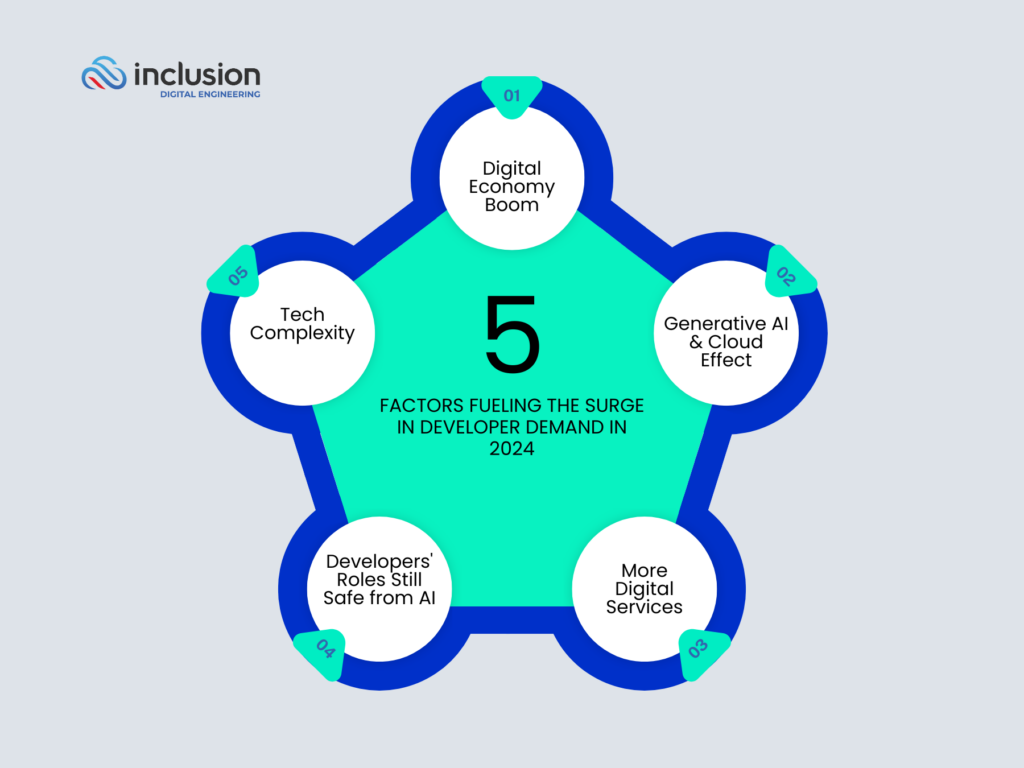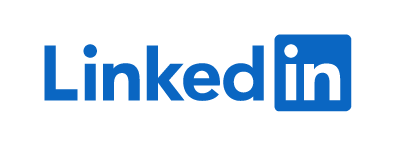More than 60% of companies are planning to hire new roles to their teams, signaling the end of the hiring freeze that marked much of 2023.
In our forecasts, we anticipate a surge in developer demand in 2024, driven by various technological, economic, and social factors, which we’ll explore in detail throughout this article. Developers are expected to play a central role in many of the most valuable initiatives this year.
Despite prevailing uncertainties, we expect an 8% increase in IT spending this year, driven by the growth of generative AI initiatives. However, this uptick in spending presents a challenge: 60% of organizations will face a skills gap and difficulties in attracting top talent.
Discover the five key reasons behind this surge in demand and how it will impact the software development landscape in 2024.
5 Essential Factors Fueling the Surge in Developer Demand in 2024

Are you looking for job opportunities with top U.S. companies? Check out our open positions here.
Reason #1: The Digital Economy Boom
The world’s transition to a digital economy is not a recent development but is gaining significant momentum. This ongoing trend is exemplified by the plans of US technology decision-makers, with 77% of them increasing their IT budgets for consumer-facing digital products and services in 2024.
This sustained growth is driven by the ever-increasing connectivity in our daily lives. More devices and services are becoming interconnected, driving various sectors forward. For example, e-commerce purchases are surging, digital entertainment consumption is on the rise, and cloud computing adoption is transforming business operations, data storage, and application access. Additionally, the emergence of financial technology (fintech) companies is disrupting traditional banking and finance sectors, with innovations such as mobile payments, peer-to-peer lending, and digital currencies creating new opportunities.
Nearly 90% of board directors recognize that digitalization is integral to all business growth strategies. Consequently, many US companies are embarking on digital transformation journeys to fully digitize their operations. This approach aims to leverage customer journey data to personalize offerings and enhance customer loyalty.
In this context, several tech roles are indispensable for designing, developing, and maintaining software applications, as well as optimizing cloud environments and ensuring cybersecurity. These roles include:
- Software Developer
- Data Scientist
- Cloud Architect
- UX/UI Designer
- AI/Machine Learning Engineer
- IT Project Manager
- Systems Administrator
- Cybersecurity Specialist
These professionals play essential roles in keeping systems operational and driving digital innovation across industries.
Reason #2: The Generative AI & Cloud Effect
We’ve moved from talking about AI to applying AI at scale,” said Microsoft Chief Executive Satya Nadella. This booming adoption of cloud computing and generative AI is creating a perfect storm that’s driving unprecedented demand for skilled developers, while the market is predicted to reach almost 188 billion U.S. dollars by 2030.
Let’s explain this phenomenon:
Cloud platforms offer several advantages that make them ideal for developing and deploying complex AI models. Firstly, the cloud’s inherent scalability allows developers to easily ramp up processing power as needed when training resource-intensive AI models.
Secondly, cloud infrastructure provides the flexibility to experiment with different AI architectures and tools without significant upfront investments. This agility is crucial for businesses trying to stay ahead of the market.
However, the cloud-based AI development comes with its own set of challenges. Building and fine-tuning these models often requires a high level of expertise. Developers need a deep understanding of machine learning algorithms, data science principles, and the specific nuances of the cloud platform being used.
Additionally, with the constant evolution of AI tools and libraries, developers must possess strong learning and adaptation skills to stay current.
Generative AI, while automating some aspects of the development process, introduces a new layer of complexity. These AI tools can generate code, translate languages, and even create creative content. However, to leverage their potential effectively, developers need to understand the capabilities and limitations of these AI assistants. They must be able to assess the quality of the AI-generated outputs, identify potential biases, and ensure these outputs integrate seamlessly with existing systems.
This necessitates a new breed of developer with a hybrid skillset, combining traditional programming prowess with expertise in AI and cloud architecture.
Reason #3: Customers Want More Digital Services
Customers want more digitized services primarily for the convenience, efficiency, and personalized experiences they offer.
Firstly, digitized services provide 24/7 availability, allowing customers to engage with businesses at any time of the day or night, regardless of traditional operating hours. This round-the-clock accessibility ensures that customers can make purchases faster and do not have to wait to the store is open. A Salesforce report says that 81% of customers expect faster service as technology advances.
Secondly, digitized services enhance accessibility by breaking down geographical barriers and eliminating the need for physical presence. Customers can interact with businesses from anywhere in the world, using various digital devices such as smartphones, tablets, or computers.
Thirdly, digitized services offer the possibility of personalized experiences using insights from data to learn about customer preferences and behaviors. Personalization is a key advantage of digital services, as it caters to individual customer needs and preferences. Research shows that 71% of customers expect companies to deliver personalized interactions, while 76% become frustrated when they don’t receive relevant recommendations or offers.
Again, to effectively implement and maintain these levels of personalization, it is crucial to have developers on board who are experts in data analytics, machine learning, and user experience design.
Reason #4: Developers’ Roles Still Safe from AI
We definitely believe that in 2024, AI isn’t ready to take developers’ jobs. While there are plenty of amazing tools out there that assist developers in coding, humans are still fundamental to grounding the code that AI can write, strategizing, writing prompts, and reviewing the outputs.
We are sure that generative AI is an incredible coding assistant, capable of significantly boosting productivity and reducing the time-to-market of products. Forrester has developed the concept of TuringBots, AI-powered tools that assist software developers and entire development teams in planning, designing, building, testing, and deploying application code. These bots can enhance software development lifecycle productivity by 15% to 20%, potentially resulting in 10% of worldwide code being generated by AI-enhanced software development tools.
In short, Large Language Models (LLMs) lack the nuanced judgment needed for autonomous action, a critical factor in sectors reliant on digital infrastructure, such as banking, investment, and manufacturing. Given the importance of error-free code in these areas, the potential for LLMs to produce inaccurate or “hallucinated” content poses significant risks. Ensuring the integrity and reliability of digital assets requires meticulous human oversight to mitigate the limitations of LLMs and safeguard our modern digital ecosystem.
Reason #5: Tech Complexity Calls for Specialization
With the increasing complexity of systems, algorithms, and software, the need for specialists is fiercer than ever.
Plus, companies need to keep pace in their cutting-edge projects, such as those integrating generative AI, cloud solutions, blockchain, and more. This is why the demand for specialized talents in these fields has skyrocketed. As previously mentioned, there’s a looming threat of unfilled jobs due to the skills gap. By 2030, more than 85 million jobs might go unfilled because there aren’t enough skilled people to take them, according to Korn Ferry. Without that talented workforce, companies could lose out on $8.5 trillion in annual revenue.
This escalating demand for developers is expected to heighten further this year. A potential solution to this challenge is nearshoring, which offers companies a way to access the specialized talent they need by broadening their search to include countries that share a similar time zone and work ethics.
Why Nearshoring is Key to Meeting Developer Demand
After the uncertain times that forced businesses to put the brakes on hiring and slow down the pace of some initiatives, the landscape in 2024 is different.
The factors mentioned throughout the article have led to an increased demand for software developers. However, this surge has brought challenges: the competition for talent is fiercer than ever, as specialists are needed to successfully navigate cutting-edge initiatives involving generative AI, cloud, automation, and other emerging technologies.
This high demand could lead to skyrocketing wages for top talents, especially for those talents with seniority who can truly make a difference between success and merely wasting time and money.
Here’s why nearshoring emerges as a cost-effective alternative for recruiting the talent you need. By expanding the talent pool to regions with more affordable rates (due to the lower cost of living in those regions, such as Latin America) and a less tapped pool of talent, you don’t have to sacrifice quality for costs.
Latin America is home to top 1% professionals. This distinction is attributed to the region’s esteemed technical universities that nurture a level of expertise and work ethic parallel to that found in the U.S. Moreover, the region’s commendable English proficiency further amplifies its attractiveness as a hub for tech talent, ensuring seamless communication and integration with international teams.
Thus, you can augment your U.S. team, maintaining control of the project with specialized talent without risking your IT budget and working seamlessly during the same work hours and with fluent communication between team members.
Want to start winning the competition for talent? Contact us; we’re eager to address your concerns and assist with your cutting-edge initiatives.
Also, you can follow us on LinkedIn for more industry insights and the latest technology trends!





